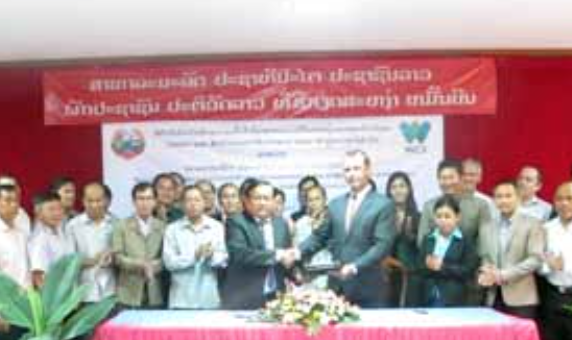The Wildlife Conservation Society (WCS) Laos Programme will work closely with the Ministry of Agriculture and Forestry to protect and conserve the unique and important species, habitats, and ecosystems in Borikhamxay province.
An agreement on the Integrated Ecosystem and Wildlife Management Programme Phase 3 was signed on Wednesday by WCS Greater Mekong Region Director and Country Programme Director, Dr Christopher Holmes, and Director of the Borikhamxay provincial Agriculture and Forestry Department, Mr Khamphiou Phimmathath.
The five-year programme will run until 2020 through financial support of more than 16.9 billion kip (US$ 2,055,684) from the Theun-Hinboun Power Company, Critical Ecosystem Partnership Fund, Cargill, Macarthur, European Union, AFD, and the United States Fish and Wildlife Service.
This agreement will build on more than 10 years of partnership through a programme of community engagement and livelihood development, and biodiversity and watershed management. Under the agreement, the programme will launch at the Nam Kading National Protected Area, Phou Si Thone Endangered Species Conservation Area, and Nam Gnouang South Protection Forest Area. The programme will help Borikhamxay to work in conservation forests and protection forests, with agreement to work in areas where other projects already exist, or are proposed based on discussion prior to the activity implementation.
The overall goal of the programme is to conserve and manage the forest resources and biodiversity within conservation forests, including protected areas and protection forests in support of efforts to improve local livelihoods sustainably.
The vision for Phase 3 of the programme is to continue to support the government to protect and manage the unique ecosystems within protected areas of the province so that they thrive indefinitely and are valued by the people of the Laos, and the world, for the biodiversity and services that they provide to both local communities and the nation.
Phase 3 contains components that build on Phases 1 and 2, which strengthened government capacity and supported the livelihoods of local communities.
The programme contributes to achieving government commitments under international conventions on biological diversity and on International Trade in Endangered Species of Wild Fauna and Flora.
The programme also aligns and contributes to specific government strategies and plans, including the National Socio-Economic Development Plan until 2025 and Vision until 2030, Five Year National Socio-Economic Development Plan for 2016-2020, Forestry Strategy to the Year 2020, Biodiversity Strategy and Action Plan 2010-2020 and other plans.
The Northern Annamite Mountains have the highest concentration of endemic species for a continental area in the world and are recognised globally for their biodiversity, ranked as one of the world’s 200 most important eco-regions.
This eco-region, which includes many forest areas in Borikhamxay, also supports some of Southeast Asia’s most charismatic species including Asian elephants, gibbons, and Annamite endemic species such as the Saola and Annamite striped rabbit, to name only a few.
In Borikhamxay province, the WCS Laos Programme works in partnership with the Lao government and local communities to conserve ecosystems and biodiversity.
Source: Vientiane Times



